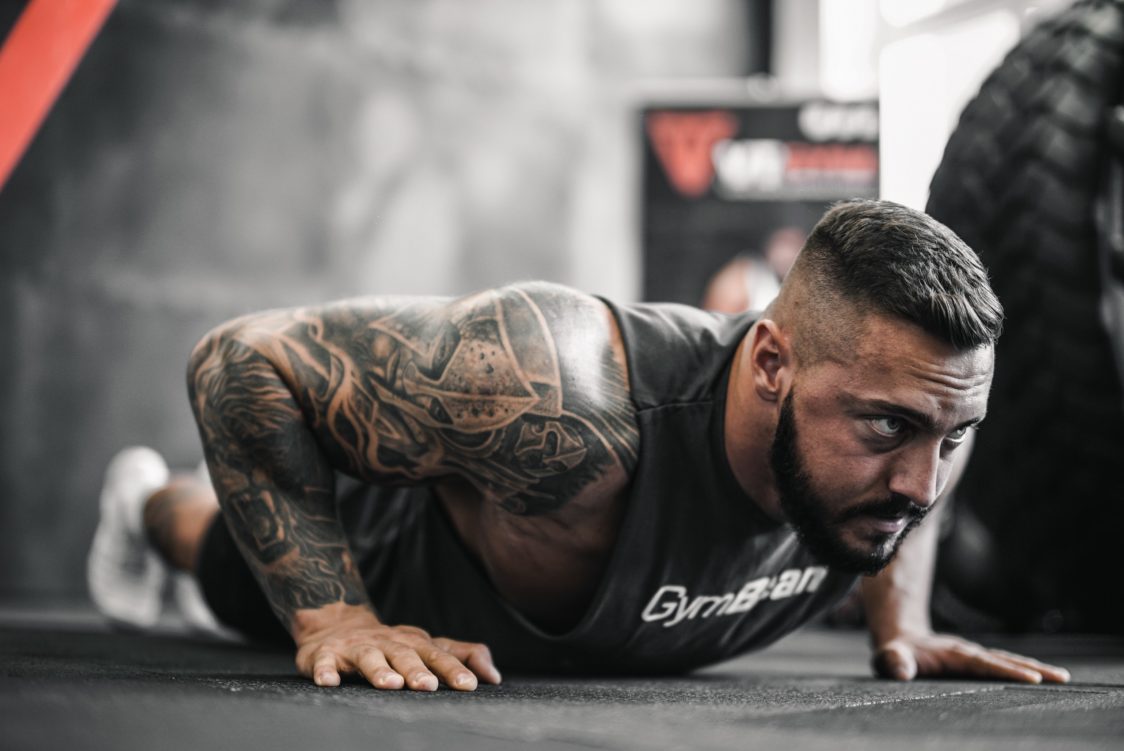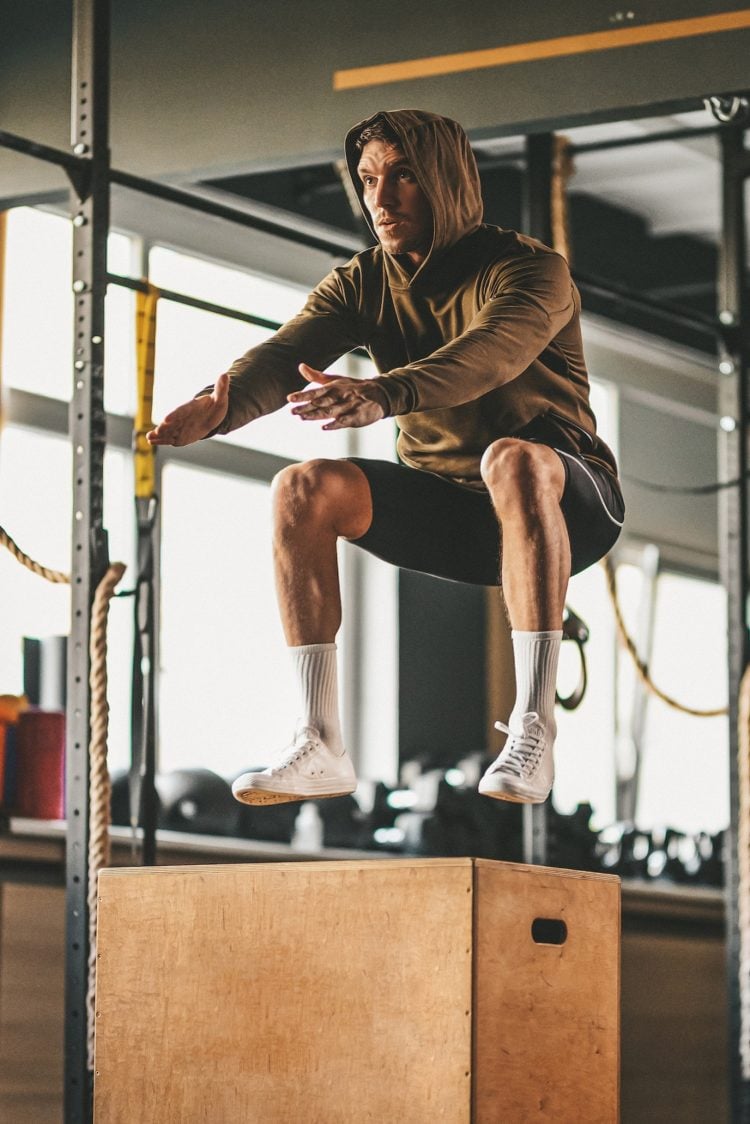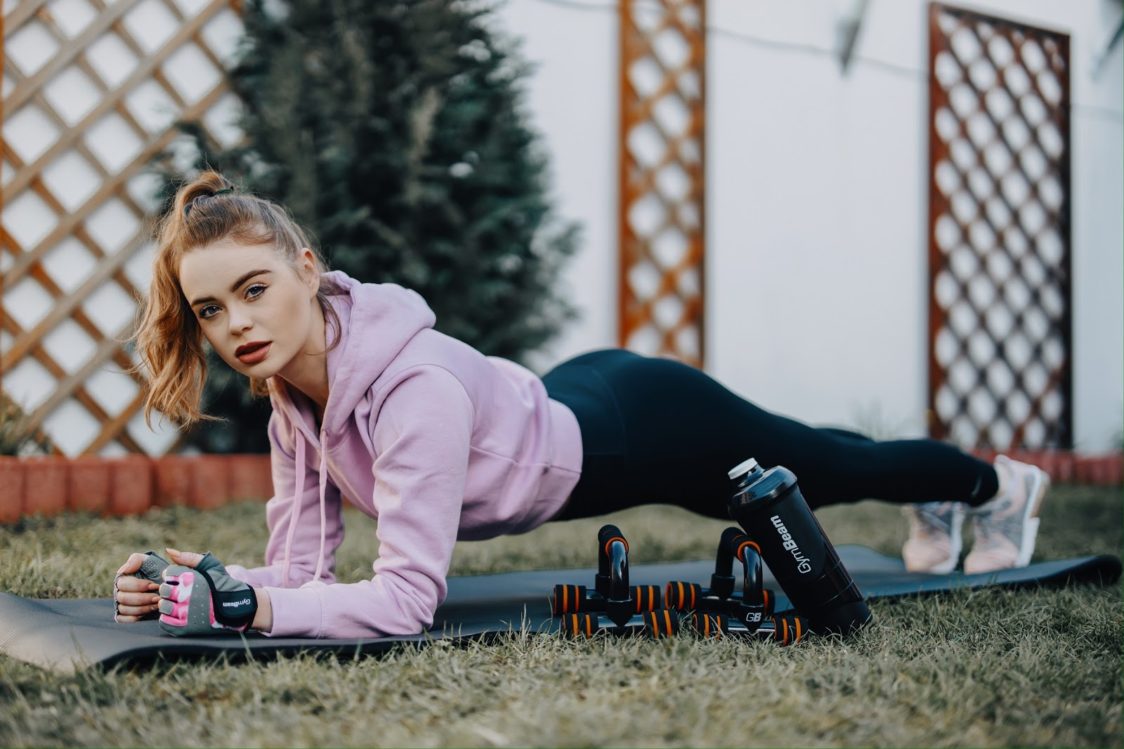Table of Contents
If you don’t have a home gym and you are used to exercising in the fitness center, it might be quite difficult to switch to home workouts. Unfortunately, doing regular bodyweight squats or squats with improvised weight may not be such a challenge as to put maximum weight on the bar, and try to set a record. However, you can make your home workouts challenging even without any fitness accessories! Here are our best tips to make it work.
Won’t my muscles disappear if I only exercise with my own weight?
The loss of muscle mass generally occurs within the first 10-14 days without exercise. However, do you feel that your muscles are getting smaller even after a few days without exercise? This is due to the loss of muscle glycogen and water, which is caused by a workout break. [1–2]
Considering the basic workout plan recommendations, you should have 3-4 workouts per week, with 3-4 sets of 3 exercises per large muscle part and 2 exercises per smaller muscle part. This implies that to maintain muscle mass, it is enough to have full body workout at least twice a week, with 1-2 demanding exercises per muscle part, and with repetitions to muscular failure. [3–4]
As you can see, any workout is better than no workout. I dare say that most people exercise several times a week, but the main problem is maintaining the intensity of training without fitness accessories.
What should home workout without fitness accessories look like?
- First and foremost, you should enjoy it and it should be challenging enough.
- As in the gym, even home workout should be demanding and intense.
- The sets should be exercised almost until the muscle failure.
Of course, one can practice push-ups or regular squats while watching the entire episode of their favourite series, while others are close to muscular failure after 20 reps. Therefore, it is necessary to look for other ways to make your workout more demanding and increase its intensity. Also, you should not forget about quality nutrition with sufficient protein intake. Not sure how to build a home workout plan? Read our article How to set a quality training plan for home workouts?

You might be interested in these products:
10 ways to make home workout more challenging
1. Slow down when performing the exercise
When planning strength workout, the Time Under Tension (TUT) variable is generally very often overlooked. It refers to how many seconds you perform one rep or set within one exercise or muscle part. Simply put, it is time when the muscle is under tension. Also, it is important not to overdo it. According to Shoenfeld (2015), the maximum estimated time to perform one rep in relation to muscle hypertrophy should be 8 seconds. Studies suggest that time longer than 10 seconds is rather counterproductive in this respect. [5]
You certainly know that doing squats or push-ups very quickly is not as difficult as when slowing down the tempo, especially in the eccentric (lowering) phase of the movement. Focusing on the eccentric phase of the movement also leads to greater muscle damage caused by exercise, and thus greater muscle hypertrophy. [6–7]
If you want to try new exercises, read our article 12 no-equipment exercises to get you in shape.
How to make use of slow exercise tempo?
- Slow down in the eccentric (lowering) phase of the movement and count to 6. Then return to the starting position. This rep should take about 8 seconds. As a bonus, for example, if you do slow push-ups, your core will be engaged more effectively.
2. Speed up and try HIIT or plyometric training
Higher intensity is typical for HIIT and plyometric training. There are many HIIT workouts to choose, you can even create your own HIIT workout with any exercises you like. All you have to do is alternate the intervals of maximum intensity effort with intervals of rest, in 2:1 ratio. In this way you will make your home cardio workout even more challenging.

With HIIT workout, you burn more energy and work more on your physical condition than with classic cardio. HIIT is generally 30 minutes of intense exercise. Thanks to the After Burn effect, your metabolism will be accelerated for a few more hours after training. Your body will also burn a little more calories even at rest. [8–9]
Plyometric training is used in almost all sports to increase speed, dynamics and explosiveness. Its goal is to quickly alternate the eccentric and concentric phases of the movement, involving such activities as jumping off a box with both feet together and then immediately performing a maximal jump back onto the box. For example, for squats, you can add a classic jump or box jump, which will be performed with maximum effort to activate the fast-twitch muscle fibers and build strength. Plyometric training also increases the performance of the neuromuscular system, which improves sports performance. [10]
How to do HIIT or plyometric training?
- Instead of the number of repetitions, focus on time. You can also use the timer or any app for HIIT training. For example, you can try popular tabata workout, where you exercise for 8 rounds with 20 seconds of max intensity effort and 10 seconds of rest. During plyometric training, the rest interval should last about 30-60 seconds or 3-5 times during exercise time.
3. Make use of the full range of motion
Have you ever wondered if you make use of each exercise and reach the full range of motion? This means that with squats you go down as low as possible in the lowering phase of the movement. The same applies to push-ups and lunges. This recruits more muscle fibers, increases the difficulty and allows building muscles and strength more effectively. If you lack strength or mobility to perform a deep squat, work on improving it, for example, by performing partial squats using a full or near full range of motion.
The effectiveness of using full range of motion was also demonstrated by a study that tested its use in bench press exercises. (Un)surprisingly, the best results were achieved by a group of athletes who used the full range of motion, compared to 1/3 or 2/3 of the maximum range of motion. [11]
4. Hold for a while in the marginal position of the exercise, you can also use pulsing
To achieve greater muscle tension, and thus greater training intensity, do pauses (1 – 3 seconds), or pulses in the lowering phase of a movement. If you are strict enough on yourself, after the first few reps you will feel muscle burn, which means that your body is forced to work harder. For example, you can do 5 or 10 small pulses at the bottom of a squat, and then return to the starting position. In this way, you will use the full range of motion and get more out of your workout.
5. Try unilateral exercises
You can switch up most bilateral exercises with unilateral alternatives. An example could be a one-leg squat or single-arm plank. You will start working more on stability during exercise and in the case of single-arm plank, you will also engage obliques. Another example is single arm reverse fly with water bottle or with a heavy shopping bag, which also engages core muscles.
If you are interested in the benefits of plank exercises, read our article What happens if you do plank every day.

6. Do more repetitions
It may be a very obvious strategy to make your exercise more challenging, but it is worth mentioning. If you don’t use any load and your workout is becoming too easy for you, try doing more reps. Higher repetitions cause metabolic stress, which is one of the primary mechanisms that stimulate muscle growth.
7. Shorten the rest interval
By reducing rest intervals, you reduce exercise time, which leads to more metabolic stress, similar to the previous tactic. Muscles simply work harder. Start by shortening your rest intervals by 10 seconds, depending on your workout.
8. Load the muscles at a different angle
What is the first thing you’re going to do when traditional push-ups become too easy for you? That’s right, you should perform reps with your feet elevated, for example, on a couch, chair, or table. This will increase the load on the upper half of the body, forcing the muscles to work harder. You can use the same principle for glute bridge with your feet on an elevated platform, which will help you to work on your buttocks and hamstrings more effectively.
9. Be creative and combine exercise types
How to spice up your workout and make it even more challenging? Combine multiple types of exercise. For example, use a static-hold position or pulsing and then plyometrics for your squats. At the beginning, do 10 squats, then pause at the bottom of a squat for 10 seconds or make 10 small pulses. Finish the whole set with jump squats. Making your exercise more challenging is up to you and your fitness level, and there are many possibilities.
10. Use everything the house gives as an external weight
- Canned food, such as chickpeas or beans, various large plastic bottles filled with water or sand. You can use hydrator and water barrels as a load instead of classic dumbbells.
- You can use a backpack filled with books or plastic bottles filled with water as a load for squats, lunges and other lower body exercises, as well as with plank or push-ups.
- Use shopping bags filled with books or plastic water bottles for biceps, triceps or shoulder exercises.
- Use furniture, but be careful not to get hurt, or destroy the flat. If you have a small coffee table in the living room, you can use it, for example, for back rows. The chair or couch, can be used for triceps or regular push-ups.
- Wondering how to make a barbell? Take an old wooden broomstick or an old hockey stick and put shopping bags or a backpack filled with books on each side. You can tape your “weights” together with duct or carpet tape.
- Use your partner weight, for example, for squats, push-ups or plank exercises. For example, you can ask him/her to put their feet on your back and try to hold the plank as long as possible.
If you don’t want to improvise, get resistance bands, a suspension workout system or dumbbells to equip your home gym.
If are you feeling unmotivated to exercise, read our article 5 tips how to stay active, motivated and never stop exercising even at home.

What to remember?
Home workouts without fitness accessories do not have to be boring, and they can be challenging. Of course, not as challenging as gym workouts, but where there’s a will, there’s a way. You should also remember that to maintain muscle mass, it is enough to have about 1-2 workouts per week, with 1-2 demanding exercises per muscle part, and with repetitions to muscular failure.
You can also use your household items as fitness equipment to make your workout harder. You can get inspired by our tips in this article.
How are you dealing with home workout? Share with us in the comments your advice, tips, gadgets that you use in home workout. If you liked the article and it was useful for you, support it by sharing it so that your friends can improve their home workouts too.
[1] Jespersen, J. G., Nedergaard, A., Andersen, L. L., Schjerling, P., & Andersen, J. L. – Myostatin expression during human muscle hypertrophy and subsequent atrophy: Increased myostatin with detraining. – https://doi.org/10.1111/j.1600-0838.2009.01044.x
[2] Nygren, A. T., Karlsson, M., Norman, B., & Kaijser, L. – Effect of glycogen loading on skeletal muscle cross-sectional area and T2 relaxation time. – https://doi.org/10.1046/j.1365-201X.2001.00913.x
[3] Bickel, C. S., Cross, J. M., & Bamman, M. M. – Exercise dosing to retain resistance training adaptations in young and older adults. – https://doi.org/10.1249/MSS.0b013e318207c15d
[4] Brad Schoenfeld – The Mechanisms of Muscle Hypertrophy and Their Application to Resistance Training – https://doi.org/10.1519/JSC.0b013e3181e840f3
[5] Brad Schoenfeld – Effect of repetition duration during resistance training on muscle hypertrophy: A systematic review and meta-analysis. – https://doi.org/10.1007/s40279-015-0304-0
[6] McHugh, M. P., Connolly, D. A., Eston, R. G., & Gleim, G. W. – Electromyographic analysis of exercise resulting in symptoms of muscle damage. – https://doi.org/10.1080/026404100365063
[7] Farthing, J. P., & Chilibeck, P. D. – The effects of eccentric and concentric training at different velocities on muscle hypertrophy. – https://doi.org/10.1007/s00421-003-0842-2
[8] Matsuo, T., Saotome, K., Seino, S., Shimojo, N., Matsushita, A., Iemitsu, M., Ohshima, H., Tanaka, K., & Mukai, C. – Effects of a low-volume aerobic-type interval exercise on VO2max and cardiac mass. – https://doi.org/10.1249/MSS.0b013e3182a38da8
[9] Laforgia, J., Withers, R. T., Shipp, N. J., & Gore, C. J. – Comparison of energy expenditure elevations after submaximal and supramaximal running. – https://doi.org/10.1152/jappl.1997.82.2.661
[10] Davies, G., Riemann, B. L., & Manske, R. – CURRENT CONCEPTS OF PLYOMETRIC EXERCISE. – https://www.ncbi.nlm.nih.gov/pmc/articles/PMC4637913/
[11] Martínez-Cava, A., Hernández-Belmonte, A., Courel-Ibáñez, J., Morán-Navarro, R., González-Badillo, J. J., & Pallarés, J. G. – Bench Press at Full Range of Motion Produces Greater Neuromuscular Adaptations Than Partial Executions After Prolonged Resistance Training. – https://doi.org/10.1519/JSC.0000000000003391


Add a comment